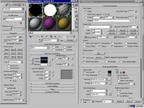 |
|||||||||
|
|
||||||||||||||||||
|
|
| Want to leave us a comment about the site or in general? Click here to access the form. |
 |
|
Simulating DOF in 3DSMAX Renders Using Photoshop by: Michael Watkins Added on: Wed Nov 28 2001 |
|
| Page: 1 2 3 | |
Depth of Field (DOF) is the total distance, on either side of the point of focus, which , when viewed from an appropriate distance, APPEARS sharp in the final print. This is an effect in photography produced by light being bent in the cameras lens. In 3D there is no lens and therefore your 3D package will need to fake DOF. One problem found in most 3d rendering systems is that your program will not take into account a reflected image when calculating DOF. This is because the 3D program will only measure the distance to the mirror when making its DOF calculations, but will not include the distance measured from the camera to the reflective surface, plus the distance from the reflective surface to the reflected object needed to calculate the true DOF of the reflected object. This tutorial is set up to help fake that distance calculation. Distance in 3D studio max is usually calculated with a greyscale image and is called a z-buffer. However, that greyscale image will not be show in a reflection. Fog however will reflect in a raytraced reflection, So if we had pure black objects with white fog, the distance from the camera will be set by the fog and the fog will be reflected in the mirror. Here is have created a simple scene with a sink infront of a mirror and two mirror balls are on the counter.  I have used Brazil r/s to render the scene but any renderer can be used seeing as how the DOF effect will be created in Photoshop as opposed to being done in 3D Studio MAX. Setup two material slots to help with the DOF effect. First will be pure black with 100% self illumination and 0 for specular level and glossiness.  Render your image normal with all the textures and materials you need, and save that as the diffuse file. |
Best viewed in 1024x768 or higher,
using any modern CSS compliant browser.